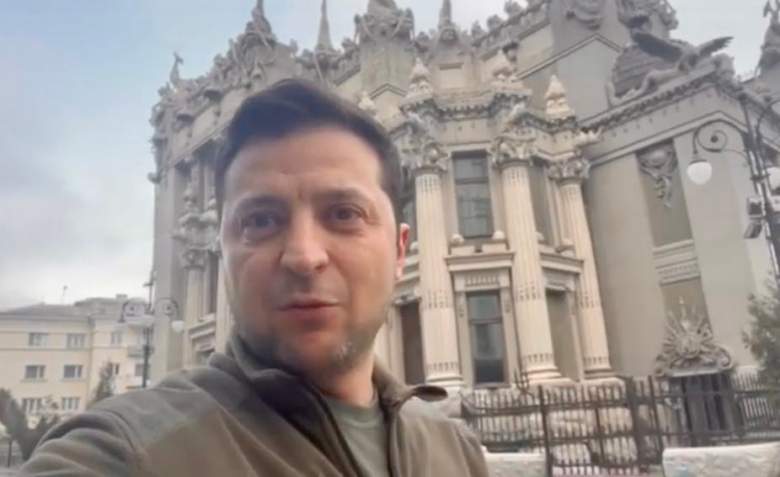
It seems straight out of an action movie: As the capital city becomes a war zone, the defiant president looks into the camera and delivers a clear and compelling message: “I am here. We will not lay down any weapons.”
That’s exactly what Ukrainian President and onetime actor Volodymyr Zelenskyy did on Feb. 25, 2022, in a selfie-style video viewed 3 million times within an hour – part of an effort to mobilize international opinion against the Russian invasion of his country. And it appears to be working. The comedian-turned-politician is credited with convincing European leaders to take actions considered unthinkable just a week ago, such as Germany sending weapons directly to Ukraine.
But what is it about his videos – made with an iPhone and posted on social media sites like Facebook, Telegram and Twitter – that have been so compelling in rallying global public opinion behind Ukraine and against Russia?
As an expert in digital social media platforms, I believe there are three reasons Zelenskyy’s videos instantly made the war in Ukraine deeply personal and resonant for so many. And in particular for this analysis, I want to single out videos posted on Feb. 25 and Feb. 26, which seem to have garnered the most attention.
An Authentic Message
The first is the authenticity of the message.
The video shot on Feb. 25, late Friday night in Kyiv, shows Zelenskyy and his cabinet standing in front of streetlights with the president speaking directly into the camera without teleprompters or any official paraphernalia in sight. At one point, Ukrainian prime minister Denys Shmyhal, standing behind Zelenskyy, displayed the time stamp on his phone to highlight the moment it was taken.
In an era in which most of us have made selfie videos or participated in group video chats with family members, the ordinariness of the scene, belied by the terrifying urgency of the message – “We are here, our soldiers are here, the citizens of our country are here” – underscored the authenticity of his appeal.
Conveying apparent authenticity is one tactic both Barack Obama and Donald Trump used to become president and inspire their followers.
Zelenskyy, who now has 13.5 million followers on Instagram, has been able to use this same skill to galvanize the majority of the world behind Ukraine.
Connecting With the Audience
A second reason his videos were so effective is they connected with viewers on social media.
Social media amplifies the visibility of a message when users feel personally connected with the content, turning them essentially into opinion-makers when they share it with like-minded people.
This is precisely the effect companies seek when they post messages to social media in an effort to highlight a new product or something else. My research shows that their posts have more power and are more likely to influence consumers when users co-opt these branded messages with their own social media posts. For example, Starbucks has had success getting young “influencers” to repost images of the company’s maritime logo of a mermaid by making it seem cool.
Zelenskyy’s message emphasizing the unity of his people and a sense of solidarity created a connection with many of the people who viewed his videos. And with a compelling and direct message, the posts appealed to a wide variety of international audiences on social media and humanized the conflict.
Immediacy of the Message
A third reason why these videos are compelling is the immediacy of his message.
Zelenskyy’s appeal for aid on behalf of his people – as missiles and bombs were falling throughout his country – was as urgent as one can be. This turned millions of users into instant recruits for his cause of raising international pressure to help him repel the Russian invasion.
“I need ammunition, not a ride,” Zelenskyy reportedly told U.S. officials who had offered to spirit him out of the country.
Research shows that messages that seem urgent are more likely to prompt an emotional response, which increases the number of people posting and sharing the post. This cascade of conversations causes it to “trend,” which tends to spark more discussion between users and thus makes the message even more visible.
That’s how digital activists raising money for a cause like disaster relief aim to engage social media users to quickly generate aid for victims. In just a matter of a couple of days, the hashtag #standwithukraine went viral and financial aid began pouring in. Ukraine has raised US$22 million in cryptocurrency donations so far.
Social media platforms are all about reach and engagement. The urgent messages posted by Zelenskyy were instrumental in seeding an army of online users who broadcast their commitment by sharing details of fundraisers or charities to support the Ukrainian people.
The Everyman-Turned-War Hero
Social media platforms help shape how people understand the world and structure how they respond to news as it unfolds. Zelenskyy seems to intuitively understand the rules of engagement on social media, which makes sense given his previous career as an entertainer.
His videos are short, between four and seven minutes, to the point, relatable and very personal. Old videos of him on Ukrainian versions of “Dancing with the Stars” and voicing “Paddington” have resurfaced and gone viral in recent days, reinforcing his authenticity, likability and normalcy amid a very dangerous confrontation.
As a result, his messages have been exceptionally potent in catalyzing public opinion.
[More than 150,000 readers get one of The Conversation’s informative newsletters. Join the list today.]![]()
By Anjana Susarla, Professor of Information Systems, Michigan State University
This article is republished from The Conversation under a Creative Commons license. Read the original article.